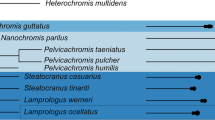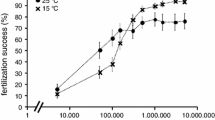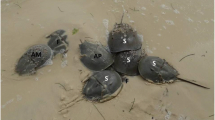Abstract
Under sperm competition, a male’s fertilization success depends largely on the ejaculate characteristics of competing males. Theoretical models predict that, in external fertilizers, increased risk of sperm competition should result in selection for increased sperm swimming speed. To test this prediction, we studied the behavior of sperm from parental and sneaker male bluegill (Lepomis macrochirus), a fish species characterized by high levels of cuckoldry due to alternative reproductive tactics of males (parentals and cuckolders). Because cuckolders (sneakers and satellites) always spawn in the presence of a parental male, but the reverse is not true, cuckolders experience the greater risk of sperm competition. We show here that the spermatozoa of sneakers have faster initial swimming speeds but shorter periods of motility than the sperm of parental males. Moreover, we show that sperm swimming speeds shortly after activation (when most fertilization occurs) are correlated with starting ATP levels in spermatozoa, suggesting that sperm competition has selected for higher energetic capacity in the sperm of sneakers. Thus, the higher energetic capacity and initial swimming speed of sneaker sperm may explain why, despite having fewer sperm per ejaculate than parentals, sneakers fertilize more eggs than parental males when they compete to fertilize a clutch of eggs.



Similar content being viewed by others
References
Ball MA, Parker GA (1996) Sperm competition games: external fertilization and ‘adaptive’ infertility. J Theor Biol 180:141–150
Casselman SJ, Montgomerie R (2004) Sperm traits in relation to male quality in colonial spawning bluegill Lepomis macrochirus. J Fish Biol (in press)
Colgreave N, Ruxton GD (2003) Confidence intervals are a more useful complement to nonsignificant tests than are power calculations. Behav Ecol 14:446–450
Cosson J, Billard R, Cibert C, Dreanno C, Suquet M (1999) Ionic factors regulating the motility of fish sperm. In: Gagnon C (ed) The male gamete: from basic science to clinical applications. Cache River Press, Vienna, Ill., pp 161–186
Fu P, Neff BD, Gross MR (2001) Tactic-specific success in sperm competition. Proc R Soc Lond B Biol Sci 268:1105–1112
Gage MJG, Stockley P, Parker GA (1995) Effects of alternative male mating strategies on characteristics of sperm production in the Atlantic salmon (Salmo salar): theoretical and empirical investigations. Philos Trans R Soc Lond B Biol Sci 350:391–399
Gage MJG, MacFarlane C, Yeates S, Shackleton R, Parker GA (2002) Relationships between sperm morphometry and sperm motility in the Atlantic salmon. J Fish Biol 60:1528–1539
Gomendio M, Roldan ERS (1991) Sperm size and sperm competition in mammals. Proc R Soc Lond B Biol Sci 243:181–185
Gross M (1982) Sneakers, satellites and parentals: polymorphic mating strategies in North American sunfishes. Z Tierpsychol 60:1–26
Jeulin C, Soufir J-C (1992) Reversible intracellular ATP changes in intact rat spermatozoa and effects on flagellar sperm movement. Cell Motil Cytoskeleton 21:210–222
Jobling S, Coey S, Whitmore JG, Kime DE, Van Look KJW, McAllister BG, Beresford N, Henshaw AC, Brighty G, Tyler CR, Sumpter JP (2003) Wild intersex roach (Rutilus rutilus) have reduced fertility. Biol Reprod 67:515–524
Katz DF, Drobnis EZ (1990) Analysis and interpretation of the forces generated by spermatozoa. In: Bavister BD, Cummins J, Roldan ERS (eds) Fertilization in mammals. Sereno Symposia, Nowell, Mass., pp 125–137
Kime DE, Van Look KJW, McAllister BG, Huyskens G, Rurangwa W, Ollevier R (2001) Computer-assisted sperm analysis (CASA) as a tool for monitoring sperm quality in fish. Comp Biochem Physiol C 130:425–433
Lahnsteiner F, Berger B, Weismann T, Patzner RA (1998) Determination of semen quality of the rainbow trout, Oncorhynchus mykiss, by sperm motility, seminal plasma parameters, and spermatozoal metabolism. Aquaculture 163:163–181
Leach B, Montgomerie R (2000) Sperm characteristic associated with different male reproductive tactics in bluegills (Lepomis macrochirus). Behav Ecol Sociobiol 49:31–37
Levitan DR (2000) Sperm velocity and longevity trade off each other and influence fertilization in the sea urchin Lytechinus variegatus. Proc R Soc Lond B Biol Sci 267:531–534
Manly BJF (1997) Randomization tests and Monte Carlo methods in biology. Chapman and Hall, London
Parker GA (1990) Sperm competition games: sneaks and extra-pair copulations. Proc R Soc Lond B Biol Sci 242:127–133
Rice W (1989) Analyzing tables of statistical tests. Evolution 43:223–225
Stockley P, Gage M, Parker G, Møller AP (1997) Sperm competition in fishes: the evolution of testes size and ejaculate characteristics. Am Nat 149:933–954
Uglem I, Galloway TF, Rosenqvist G, Folstad I (2001) Male dimorphism, sperm traits and immunology in the corkwing wrasse (Symphodus melops L.). Behav Ecol Sociobiol 50:511–518
Vladic TV, Järvi T (2001) Sperm quality in the alternative reproductive tactics of Atlantic salmon: the importance of the loaded raffle mechanism. Proc R Soc Lond B Biol Sci 268:2375–2381
Vladic TV, Afzelius BA, Bronnikov GE (2002) Sperm quality as reflected through morphology in salmon alternative life histories. Biol Reprod 66:98–105
Acknowledgements
We thank the Queen’s University Biology Station for logistic support; Christina Cliffe for help with measurements of sperm motility and sperm tail length; and Dale Roberts, Leigh Simmons and three anonymous reviewers for useful comments. Financial support was provided through Natural Sciences and Engineering Research Council (NSERC) research and equipment grants to R.M. and C.D.M., and post-doctoral fellowships to G.B. and A.I.S. R.M. was supported by a Killam Research Fellowship. All experiments were approved by the Queen’s University Animal Care Committee, and comply with the current laws of Canada.
Author information
Authors and Affiliations
Corresponding author
Additional information
Communicated by L.W. Simmons
Rights and permissions
About this article
Cite this article
Burness, G., Casselman, S.J., Schulte-Hostedde, A.I. et al. Sperm swimming speed and energetics vary with sperm competition risk in bluegill (Lepomis macrochirus). Behav Ecol Sociobiol 56, 65–70 (2004). https://doi.org/10.1007/s00265-003-0752-7
Received:
Revised:
Accepted:
Published:
Issue Date:
DOI: https://doi.org/10.1007/s00265-003-0752-7




